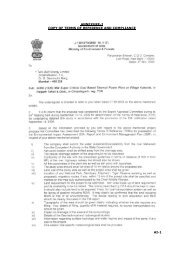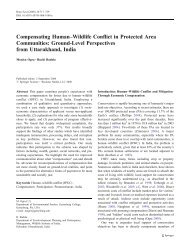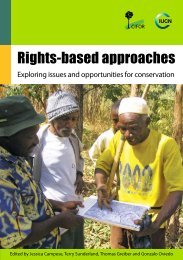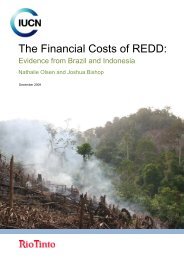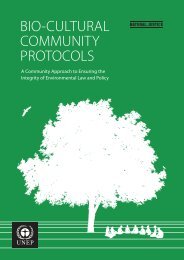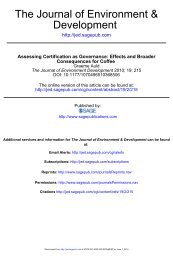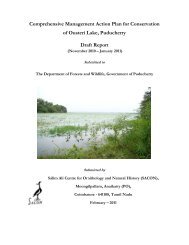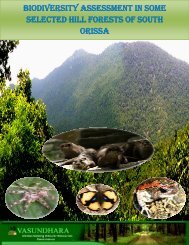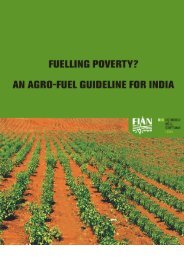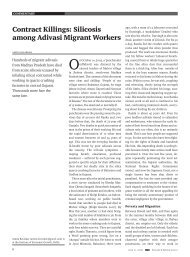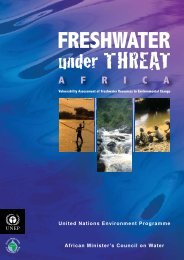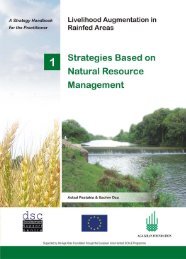Integrated River Basin Planning – Replicable ... - India Water Portal
Integrated River Basin Planning – Replicable ... - India Water Portal
Integrated River Basin Planning – Replicable ... - India Water Portal
You also want an ePaper? Increase the reach of your titles
YUMPU automatically turns print PDFs into web optimized ePapers that Google loves.
<strong>Integrated</strong> <strong>River</strong> <strong>Basin</strong> <strong>Planning</strong>: <strong>India</strong> and the EU share experience on policy and practice<br />
<strong>Water</strong> and Environmental Policies in <strong>India</strong><br />
The provision of piped water supply in rural areas is the responsibility of the<br />
state government, and funds have been provided in the state budgets right from<br />
the commencement of the first Five Year Plan. A National <strong>Water</strong> Supply and<br />
Sanitation Programme was introduced in the social welfare sector in 1954. The<br />
states gradually built up the Public Health Engineering Departments to address<br />
the problems of water supply and sanitation. In 1972-1973, the Government of<br />
<strong>India</strong> introduced the Accelerated Rural <strong>Water</strong> Supply Programme to assist the<br />
states and union territories with 100 percent grants-in-aid to implement schemes<br />
in problem villages. As a part of it, in the 1970s, more than 450 piped rural<br />
systems were launched in Kerala. During the 1980s, as part of the Drinking <strong>Water</strong><br />
Supply and Sanitation Decade Programme, several projects were launched with<br />
the support of bilateral and multilateral agencies.<br />
Kerala has a conventionally ‘water safe’ economy. However, despite heavy annual<br />
rainfall, high well density and numerous rivers and ponds, the state of Kerala<br />
is paradoxically situated among the country’s lowest per capita groundwater<br />
states. A few numbers of site-specific studies explained the ‘scarcity in the midst<br />
of plenty’ by several reasons, such as high rainwater runoff, loss of forest cover,<br />
sand mining, reclamation of paddy fields, etc. (State <strong>Planning</strong> Board 2002). It was<br />
observed that cities in the low land areas experience severe floods more often<br />
than earlier even under normal rainfall conditions. Also, many household wells in<br />
Kerala were drying up and need to be dug deeper to obtain water. Thus, even<br />
with abundant availability of water in the state, its beneficial use is constrained by<br />
many factors.<br />
There are variations in water quality between coastal, midland and highland<br />
areas of Kerala, with chloride and iron concentration being the major problems in<br />
many pockets. Wells near the coastal belt of Kollam, Trivandrum, and Alappuzha<br />
districts, some parts of Ernakulam district, and the entire Malappurum region, are<br />
rich in iron. The <strong>India</strong>n standards on drinking water prescribe a desirable limit of<br />
0.3 mg/l and, in the absence of alternate source, a permissible limit of 1.0 mg/l.<br />
There are many isolated pockets in Kerala with iron concentration above 1 mg/l,<br />
which affects the taste and appearance of water, has adverse effects on domestic<br />
use and water supply structures, and promotes iron bacteria. Besides metallic<br />
contamination, surface water in rivers is polluted by municipal and industrial<br />
discharges. Widespread biological and bacterial contamination as well as<br />
application of pesticides largely affects the water quality.<br />
With almost all the rivers in Kerala being rain-fed, any reduction in rainfall affects<br />
the water level. Declining water levels in turn affect the availability of piped water<br />
supply. Most households depend on open wells for drinking water. So, a declining<br />
water table has consequences on the family-managed drinking water supply.<br />
Table 3 provides the breakdown of source dependency of rural households<br />
for drinking water, and how Kerala ranks against the all-<strong>India</strong> average. At 58.8<br />
percent, well dependency is very high in Kerala and stands in total contrast to<br />
the all-<strong>India</strong> average of 21.3 percent. This has significant implications for IWRM in<br />
terms of water use, accessibility and equity.<br />
Table 3 Source dependency for drinking water in rural households<br />
Principal Source All <strong>India</strong> (%) Kerala (%)<br />
Tap 14.8 7.6<br />
Tube well/Hand Pump 46.5 1.2<br />
Well 21.3 58.8<br />
Tank/Pond restricted for drinking 0.9 1.1<br />
Other Tank/Pond 0.5 0.4<br />
<strong>River</strong>/Canal/Lake 1.0 < 0.1<br />
Spring 1.6 0.2<br />
Tanker 0.2 -<br />
Others 0.2 0.2<br />
Source: NSSO, 54th Round<br />
The percentage of households having sufficient drinking water throughout the<br />
year is also low in Kerala compared to other major <strong>India</strong>n states. If sufficiency of<br />
drinking water throughout the year also taken into consideration, the coverage<br />
of piped water supply in Kerala is merely 9 percent (taps and tube wells). The<br />
majority of households in Kerala traditionally depended on open wells for their<br />
household water supply needs. It has been estimated that Kerala has the highest<br />
percentage (30.4 percent) of households suffering from insufficiency of drinking<br />
water in some part of the year (NSSO). They had to find alternative sources of<br />
water supply for their domestic water needs. This seasonality of water availability<br />
is an important dimension of the water supply problem in Kerala and has major<br />
implications for IWRM.<br />
4.6 <strong>Water</strong> for agriculture<br />
The agro-climatic conditions suit the cultivation of a variety of seasonal and<br />
perennial crops. The net area sown in Kerala is estimated to be about 2 million<br />
hectares (ha). Fifteen principal crops (rice, pulses, coconut, rubber, tea, coffee,<br />
pepper, cardamom, areca nut, ginger, nutmeg, cinnamon, paddy, tapioca and<br />
other plantations) are cultivated in the state, mainly by marginal or small farmers.<br />
The key agricultural crop of Kerala is paddy. In fact, the Kuttanad region that falls<br />
in the Pamba <strong>River</strong> <strong>Basin</strong> is known as the 'rice bowl of the state'. While paddy<br />
is grown mainly for their own consumption by many households, widespread<br />
cultivation of coconut and rubber production constitutes the principal source<br />
of agricultural income. The state has a substantial share in the four plantation<br />
crops, i.e. rubber, tea, coffee and cardamom. These four crops together occupy<br />
600,000 ha, accounting for 31.4 percent of the net cropped area in the state.<br />
Kerala accounts for 92 percent of the total production of rubber, 76 percent of<br />
cardamom, 21 percent of coffee and 6 percent of tea in the country. The changes<br />
in cropping pattern during the past two decades were in favour of these crops.<br />
The major spices exported from Kerala are pepper, ginger and nutmeg. Kerala<br />
continues to enjoy a near monopoly in the cultivation area and production of<br />
pepper accounting for 98 percent in the country. The productivity of pepper<br />
26 27



